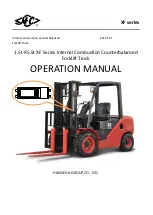
1
I. Instructions for use
In order to ensure personal and equipment safety, the driver should obey the following Precautions:
1. Only drivers with proper training and a valid license should operate the vehicle.
2. Check each control and alarm device before driving, if any damage or defects are found they should
be repaired before operation.
3. The load should not exceed the specified value when handling; the forks should be fully inserted
into the load so that it is uniformly positioned on the fork; do not use a single fork to lift cargo.
4. Start, turn, drive, brake and stop smoothly; slow down on wet or slippery roads when steering.
5. Loads should be placed as low as possible, and the mast
should tilt backward when driving.
6. Be careful when driving on ramps; move forward when driving up gradients greater than one in ten
and move back when driving down ramps; do not turn when driving up or down ramps; do not carry
out loading and unloading operations when the forklift is in motion.
7. Pay attention to pedestrians, barriers, and bumpy surfaces when driving and be aware of the upper
clearance of the forklift truck.
8. Do not stand on the forks and do not carry passengers.
9. Do not stand under the forks or walk under the forks.
10. Do not operate the truck and its accessories from anywhere except the driver’s seat.
11. Do not handle unsecured or loosely stacked cargo and be careful when handling large cargos.
12. Protect cargo on high lifting forklift trucks with a lift height of more than 3m from falling down and
take preventive measures if necessary.
13. Try to tilt the mast backward when the high lifting forklift truck is in operation and tilt forward
within the minimum range during loading and unloading operations.
14. When driving on wharfs or temporary decking, you should be extra careful and drive slowly.
15. The driver should not stay in the truck and should shut down the engine when refuelling; keep
sources of ignition away when checking the battery or fuel tank level.
16. When a forklift truck with accessories is idling, it should be operated in the same manner as a
loaded forklift truck.
17. Drop the forks to the ground, switch the gear lever to the neutral position, pull the parking brake
device properly, shut down the engine, and disconnect the power when leaving the truck. Engage the
parking brake device properly when parking on ramps, place cushion blocks under the wheels when
parking for a long time.
18. In case of a sudden fault when lifting cargo or driving on gradients, causing leakage of storage
battery electrolyte, hydraulic oil and brake fluid, or a flat tire etc., personnel should be organized for
repair immediately, the truck should be kept in a safe condition, and professional maintenance
personnel or the seller should be contacted.
19. Noise and vibration will be generated during installation and assembly processes; please choose
proper tools and assembly methods to reduce the impact of noise pollution on the environment.
20. The forklift truck must not be used in plant areas; the working surface should be solid and flat
cement pavement, asphalt pavement or concrete pavement. When there is snow, ice, water or other
foreign matter on the road, the truck can only be used after it has been fully cleared away; otherwise,
the truck is likely to lose control, resulting in an accident.
21. In the event of a breakdown, the truck should be first moved to a place where it does not obstruct
traffic. If the breakdown is caused by the brake system or steering system, the truck should be carried
Summary of Contents for XF Series
Page 62: ...59 WG3800 and LPG Fuel System Diagram...
Page 72: ...Notes...

























